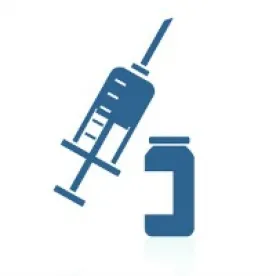In OSI Pharmaceuticals, LLC v. Aoptex Inc. (Fed. Cir. 2018-1925, Oct. 4, 2019), the Federal Circuit reversed the Patent Trial and Appeal Board’s (Board) decision that certain claims of US Patent No. 6,900,221 were unpatentable as obvious. The court determined that the Board’s finding of reasonable expectation of success was not supported by substantial evidence in light of the unpredictability in the art.
The Claims at Issue
Erlotinib (marketed Tarceva®) is an epidermal growth factor receptor (EGFR) inhibitor that treats non small cell lung cancer (NSCLC). Activation of the EGFR initiates a pathway that leads to cell reproduction. Other EGFR inhibitors for treating NSCLC had failed in clinical trials. This is not uncommon because cancer treatment is highly unpredictable. As noted by the court, “[e]ven though the EGFR was identified in some cancers as a drug target, the in vitro (i.e., in a test tube) effectiveness of a drug in inhibiting the EGFR turned out to be a poor proxy for how effective that drug actually was in treating cancer in vivo (i.e., in the body). Numerous EGFR inhibitors that showed promising in vitro activity failed for a variety of reasons. These included poor pharmacokinetics due to poor absorption or rapid metabolism (or both), undesirable drug-drug interactions, drug toxicity due to drug binding onto healthy cells, drug toxicity due to binding onto other receptors, and metabolite toxicity. Some drug candidates were limited by one or more of these shortcomings, further underscoring the unpredictable nature of cancer treatment.” Slip Op. at 3.
US Patent No. 6,900,221 (‘221 Patent) entitled “Stable polymorph on N-(3-ethynylphenyl)-6, 7-bis (2methoxyethoxy)-4-quinazolinamine hydrochloride, methods of production, and pharmaceutical uses thereof” issued on May 31, 2005 and is assigned to OSI Pharmaceuticals, LLC (OSI). Challenged claims 44-46 and 53 of the ‘221 Patent recite:
44. A method for the treatment of NSCLC (non small cell lung cancer), pediatric malignancies, cervical and other tumors caused or promoted by human papilloma virus (H[P]V), Barrett's esophagus (pre-malignant syndrome), or neoplastic cutaneous diseases in a mammal comprising administering to said mammal a therapeutically effective amount of a pharmaceutical composition comprised of at least one of N-(3-ethynylphenyl)-6,7-bis(2-methoxyeth-oxy)-4-quinazolinamine, or pharmaceutically acceptable salts thereof in anhydrous or hydrate forms, and a carrier.
45. The method of claim 44, wherein the treatment further comprises a palliative or neo-adjuvant/adjuvant monotherapy.
46. The method of claim 44, wherein the treatment further comprises blocking epidermal growth factor receptors (EGFR).
53. The method of claim 44 for the treatment of non-small cell lung cancer (NSCLC).
’221 Patent col. 35 ll. 26–42, 64–65.
The Board’s Determination
The Board had determined that the ’221 Patent claims were obvious in view US Patent No. 5,474,498 (Schnur), in view of Gibbs et al. (2000) “Anticancer Drug Targets: Growth Factors and Growth Factor Signaling”, 105 J. Clinical Investigation 9, 9-13 (Gibbs) or OSI’s Annual Report (Form 10-K, Sept. 30, 1998) (10-K).
Schnur was cited for teaching the use of a class of 4-(substituted phenylamino)quinazoline derivatives for the treatment of mammalian hyperproliferative diseases including cancers. 105 different compounds were cited as examples of such compounds. Erlotinib is listed as a preferred compound. The reference also states that these compounds are potent inhibitors of the erbB family of oncogenic and protooncogenic protein tyrosine kinases including for example epidermal growth factor receptor (EGFR), erbB2, HER3, or HER4 and therefore are all adapted to therapeutic use as cancer agents in mammals and humans. NSCLC was not recited as one of the cancers that could be treated by these compounds.
Gibbs is a review article authored by Dr. Jackson B. Gibbs that discusses various signaling mechanisms in the cell and how they are associated with tumors. The article discloses a study of erlotinib and states that the drug appears to have good anti-cancer activity in preclinical models, particularly in NSCLC patients. No data regarding the use of erlotinib to treat NSCLC was discussed in Gibbs or in any of the references cited in Gibbs. This fact was confirmed by the author, Dr. Gibbs, in a declaration submitted to the Board. Nevertheless, the Board inferred that Gibbs that erlotinib has canticancer activity against NSCLC.
OSI’s 10-K was cited for disclosing that erlotinib had reached a significant milestone with the completion of Phase I safety trials and the initiation of Phase II clinical trials in the United States in cancer patients. Similar to Gibbs, the 10-K did not disclose any data on erlotinib’s effect on NSCLC.
The Board found that the disclosures in OSI’s 10-K that erlotinib targeted NSCLC and that it had entered Phase II clinical trials would have provided a person of ordinary skill with a reasonable expectation of success in light of Schnur’s teachings, even in the absence of pre-clinical animal efficacy data. Slip Op. at 10. The Board similarly found that Gibbs provided a reasonable expectation of success even though the article was devoid of any clinical or pre-clinical data showing the effect of erlotinib on NSCLC. The Board held that claims 44 and 53 were obvious by the combination of Schnur and OSI’s 10-K, and the combination of Schnur and Gibbs. Id. Because claims 45 and 46 were not separately argued, those claims also were held to be unpatentable.
Lack of Substantial Evidence and Expectation of Success
The Federal Circuit reversed the Board’s determination that the claims were obvious in view of the cited prior art. Starting with Gibbs, the court determined that the Board’s inference that Gibbs teaches that erlotinib has antitumor activity was erroneous because none of the cited references in the review article supported the Board’s inference and Dr. Gibb’s declaration stated the same.
The court also found that there was no reasonable expectation of success. The cited art did not disclose any in vitro or in vivo efficacy data for erlotinib or suggest the use of erlotinib to treat NSCLC. Slip Op. at 15-16. The court stated that the lack of erlotinib-NSCLC data or other indication of success was significant because of the highly unpredictable nature of treating NSCLC “which is illustrated by the over 99.5% failure rate of drugs entering Phase II.” Slip Op. at 16. The court also noted that “it is undisputed that a drug’s success in treating one type of cancer does not necessarily translate to success in treating a different type of cancer, which underscores the unpredictability in cancer treatment generally.” Id. The court further found that the Board also erred by failing to consider OSI’s 10-K statement in light of the 99.5 % failure rate of 1,630 drugs entering Phase II clinical trials for the treatment of NSCLC. Slip Op. at 18.
The court concluded its review of the obviousness rejection by stating:
“To be clear, we do not hold today that efficacy data is always required for a reasonable expectation of success. Nor are we requiring absolute predictability of success. … We conclude only that, on these particular facts, a reasonable fact finder could not find a reasonable expectation of success. The Board’s finding is thus not supported by substantial evidence, and accordingly we reverse its obviousness determination.”
Id. Internal citations omitted.1
10-K Statements Are Prior Art
As articulated by the Federal Circuit, the Board here succumbed to the dangers of hindsight in conducting its obviousness analysis. The Board’s error was compounded by its misreading of the Gibbs reference and its failure to recognize the author’s declaration clarifying what the article did not disclose. While the Federal Circuit concluded that OSI’s 10-K combined with the Schnur article did not render the challenged claims of the ’221 Patent obvious, it did state that efficacy data is not always required for a finding for a finding obviousness. This should put innovators on notice that any statement made in a public document, such as a SEC filing, is fair game in an invalidity analysis.
-------------------------------------
1 OSI also challenged the constitutionality of retroactively applying IPRs to pre-AIA patents. This challenge was dismissed because the issue had been decided in other decisions, e.g., Celgene Corp. v. Peter, 931 F.3d 1342, 1362 (Fed. Cir. 2019). There, the Federal Circuit held the application of IPRs to a pre-AIA patent is constitutional.




 />i
/>i
